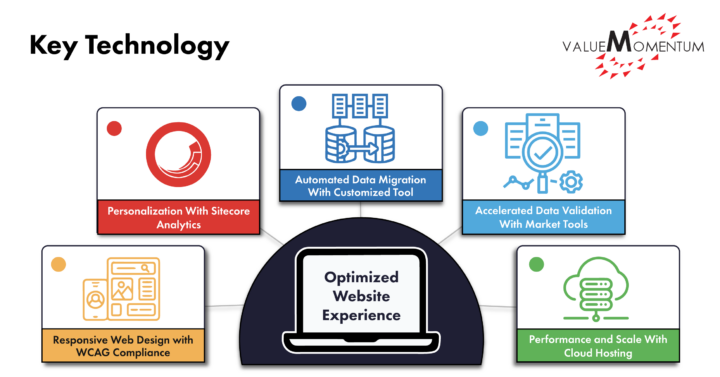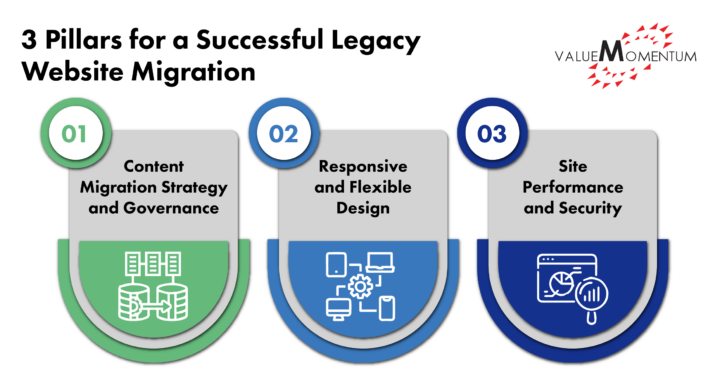Insurers face a new challenge—as a more digitally savvy customer base grows, expansion of digital infrastructure is not only recommended, but critical to business growth. Specifically, public-facing websites must accommodate the flexible access points customers want while incorporating an intelligent content management strategy.
To prepare themselves for website migration, insurers need to tackle key component updates such as revamping their website architecture, validating content, and establishing best practices. Legacy CMS, however, has hindered insurers’ ability to transition websites to new and modern platforms with improved security, accessibility, and flexibility. This challenge is even more difficult without the help of automation and other digital tools.
To resolve this challenge, a Fortune 500 insurer client partnered with ValueMomentum to migrate their legacy website to a modern platform system using Sitecore hosted on Azure. In this brief overview, we share some insights and experiences from the Digital & Cloud Services (DCS) team to provide a central framework for a successful website migration.
Use Case: Legacy Website Migration
Our insurer client wanted the ability to personalize and customize their website without a need to go through a code management and a deployment process through non-prod and prod environments. To address this need, ValueMomentum’s team partnered with the client business teams to enhance existing components and build new components, or modules, that allow content authors to work with graphical interfaces on Experience Editor and make changes directly on the pages. These components give content authors the ability to choose what they need to build and publish a page based on their content.
Our team utilized Sitecore for content management and leveraged several design and automation tools to ensure a successful implementation of the new website.
Sitecore Analytics was also a Business Intelligence (BI) feature that was made available to the marketing team as part of this migration, which enabled the insurer to provide personalized experiences to visitors.
Key Technology: Using Sitecore and Website Design Tools to Optimize Website Experience
Developing and implementing the required key features provided a general framework for the design and migration of the web pages. These features paved a smoother road to programming the modules, migrating the data, and validating them:

Responsive Web Design With WCAG Compliance
Modules were built with a responsive design approach where they dynamically change appearance based on screen the size and orientation of the device used to view the web page. The team followed web content accessibility guidelines (WCAG) while building these components and ensured the code was reusable and repeated across all modules.
Personalization With Sitecore Analytics
Integration of Sitecore analytics was done as part of the project, allowing the insurer to personalize content for visitors and policy holders. All the data collected through analytics can be converted into actionable points.
Automated Data Migration With Customized Tool
Content from the legacy platform had to be migrated to the new platform, a process which can be challenging depending on the amount of content as well as the type of content. Our team came up with an automation strategy that optimized the resource utilized for migration. Content was migrated by module using a tool available in the market which provided the ability to pull content from different sources (i.e., spread sheets, databases, etc.). This tool was heavily customized to help expedite the migration process and optimize team resources.
Accelerated Data Validation With Market Tools
Any migration would need an extensive validation to ensure there are no defects, either while building the components or during data migration. Our team utilized multiple tools to automate the validation process and complete the validation with ease and precision during data validation as well as regression testing. Our two-step approach to data migration first moved content from the source to a spreadsheet where a tool is applied to then create the content on the new system. The automation tool went through the migration steps to ensure content was migrated from our source to the destination without any issues.
Performance and Scale With Cloud Hosting
As part of the migration, the new system was hosted on Azure cloud with help in partnership with a vendor. Cloud hosting allowed the new system to be more secure as well as provide more scale and better performance of the site.
Three Pillars for a Successful Legacy Website Migration
To ensure a successful migration, our DCS team not only employed website development best practices but also focused on three key pillars that informed the process of both website creation and legacy migration. These pillars include:

-
Content Migration Strategy and Governance
The team came up with a data migration strategy early on in the project outlining the migration approach. The approach included a detailed component-level data migration, sequencing and prioritizing the building of components based on project timeline.
Content governance is another aspect which we focused on while building the new system which would allow the content authors to streamline their content approval process and make sure only approved content is allowed for consumption on their website.
-
Responsive and Flexible Design
Building the components using a responsive web design approach ensured users will be able to view the web content in multiple devices without any deterioration in their experience. The team also focused on building the components so that content authors can create pages with ease. Using Experience Editor-enabled content authors to pick the components that met their requirements, and showing them in real time how the content would be rendered in web pages, eliminated any chance of having issues once the pages were published for public consumption.
-
Site Performance and Security
ValueMomentum worked with the insurer to host the application on Azure cloud and implement cloud components like Azure Front Door and content delivery network (CDN) for additional layers of security and to help cache static content, which improved the overall site performance.
Jumpstart Your Website Migration
A corporate website is more than a website—it embodies the organization’s future. While a good first impression is key to a favorable brand image, a website must also deliver flexibility of access and reusability while driving key feedback loops for further updates and improvements.
Becoming a customer-centric insurer is important for future growth. Many new innovations for customer experience are already emerging on the market, and migrating to a modern platform can enable insurers to start leveraging these new technologies.
Ready to develop better digital experiences for your customers? Check out ValueMomentum’s Digital & Cloud Services to see how we can help you strategize and expand on your digital capabilities.
